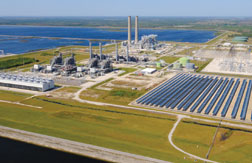 Florida Power And Light Company Solar station will use neighboring plant’s combined cycle to augment generation.
|
“We need to be able to deploy technology we are comfortable will meet the needs in Florida, is going to work, and will meet the price points we need in Florida, and that is what we are moving forward with,” says Eric Silagy, chief development officer for Florida Power & Light Co., Juno Beach.
FPL filed a petition with the Public Service Commission in May to build three separate solar projects, costing about $688 million, which will generate 110 MW of electricity. Cost recovery will be available under a law passed this year.
FPL plans to break ground this year on a 25-MW photovoltaic (PV) solar system in DeSoto County, and a 10-MW PV solar system at the Kennedy Space Center, on land leased from NASA, in 2009. FPL also will build for NASA a 1-MW PV plant to power the space center.
“I don’t think anyone has a larger single collection of photovoltaic [than the 25-MW FPL plant],” says Stephen Smith, executive director of the Southern Alliance for Clean Energy in Knoxville, Tenn. “It shows the costs are coming down to do solar. And the more solar you deploy, the more the product gets up and the lower the cost.”
The third FPL project will provide up to 75 MW of parabolic-trough solar thermal in a hybrid design at the company’s 11,000-MW, gas-fired, combined-cycle Martin Plant in Martin County, about five miles east of Lake Okeechobee.
“What’s innovative and different is we will take the solar facility and physically attach it to an existing combined-cycle, gas-fired facility,” Silagy says. “We will connect steam lines into the existing steam turbine. So whenever the sun comes out, we will simply lift our foot off the gas, and not burn gas to make steam. We will use sunlight.”
FPL dropped earlier plans for a 10-MW facility employing a compact linear fresnel reflector solar collector and steam generation system developed by Ausra Inc., Palo Alto, Calif., as a pilot for a proposed 300-MW station. “At this point, we are not moving forward with Ausra,” says Silagy.
ight months after announcing plans to build a 300-MW solar-thermal facility capable of generating about 1% of Florida’s energy needs, one of the state’s largest power utilities revealed a revised solar plan that reduces the power to be generated by the technology.

Post a comment to this article
Report Abusive Comment